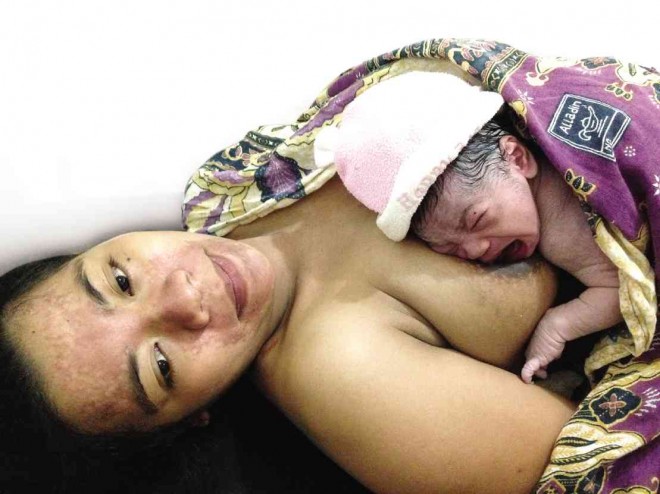Giving birth the ‘Unang Yakap’ way
Twenty-Year-Old Gina Avenido was brought to the delivery room after her water broke at 8:45 p.m.
Inside the delivery room of the rural health unit (RHU) in the town of Lebak, three midwives and two midwifery students led Gina to a delivery bed. She was ready to give birth.
Gina was brought to the same room five hours earlier when the RHU staff thought she was about to give birth. While Gina was having contractions, Dr. Maria Asuncion Silvestre, a neonatologist and consultant of Kalusugan ng Mag-Ina Inc. (KMI), advised Gina that she didn’t have to be lying down to give birth.
Silvestre and Dr. Donna Capili, another neonatologist and KMI consultant, were in Lebak on a field visit, checking on the implementation of “Unang Yakap” (The First Embrace), a step-by-step process to ensure the health of both mother and baby.
The sequence includes the thorough drying of the baby; immediate skin-to-skin contact between mother and baby; properly timed clamping and cutting of the cord; and initiation of breast-feeding.
Article continues after this advertisementUnang Yakap is the popular name of the Essential Intrapartum and Newborn Care (EINC) project that is being implemented with the help of the United Nations Children’s Fund (Unicef) and other United Nations agencies.
Article continues after this advertisementAt first, Gina thought Silvestre, Capili and Dr. Mariella Castillo, a specialist of the health and nutrition section of the Unicef, were there to attend to her. Instead, the mother-to-be had an on-the-spot educational session.
Hours before going into labor, the doctors discovered that Gina had a white cloth tied around her belly, an old practice done by a hilot (traditional birth attendant) aimed at “helping” mothers “push” their babies out.
“That’s not needed,” Castillo told Gina.
“It’s of no use. It’s like wearing a belt. When it’s too tight, you’ll have difficulty breathing,” Capili added.
Silvestre also offered water for Gina to drink, a no-no to a skilled hilot. The doctor also asked for a wet cloth to wipe Gina’s face. For Silvestre, the commonly prohibited practice of routinely not allowing food or drink is passe, and mothers should be given light snacks and water if they so desire.
“Just imagine the pain she’s going through, and yet she’s not allowed to drink, eat or even freshen up,” Silvestre said.
All these happened while Gina’s mother-in-law, Alita, silently watched as she rubbed the back of her daughter-in-law. There were no protestations from Alita, a hilot.
“I’m a hilot, but I won’t do it myself,” Alita said when asked why she and her son, Frederick, opted to have a facility-based childbirth for Gina.
“We (hilot) are no longer allowed to do that so we brought her here,” she said.
The Avenidos live in Sitio Airland in the remote village of Ragandang, more than an hour by motorcycle to the town center, where the RHU is located. As early as August, Gina was staying with her mother Teresa Gregoria’s home in the town center.
“It would be difficult for her to take an hourlong motorcycle ride, so we decided to bring her to the town center long before her due date,” Frederick said.
And Gina had her date with the delivery room on Oct. 24.
As early as 7 a.m., Gina had been experiencing contractions, but it was only after more than 12 hours that her water broke. Now lying on the delivery bed, the contractions came every 10 minutes. She continued “pushing,” amid the constant “you can do it” cheering from the midwives and the physicians.
Capili demonstrated to Gina the proper way of pushing.
“Two short and one long exhales,” Capili repeatedly told Gina, who was then pushing with her mouth closed.
At 9:50 p.m., Gina said: “I can’t do it anymore.”
As if on cue, everybody in the room cheered: “You can do it.”
Two minutes later, Gina again said: “I can’t take it anymore.”
Again, she got a “you can do it” reply.
Eleven minutes and several “pushes” later, Gina, like a lull before a storm, silently composed herself—her hands on her thighs, feet firmly pressed on the foot rest and her body in an upright position. She pushed until her baby came out.
Immediately, the baby was put on Gina’s chest for thorough drying. At the same, Castillo made the call: “Baby boy out at 10:06.”
Midwife Sharlyn Fura checked Gina’s womb for a possible second baby. There was none.
Then, Fura checked the umbilical cord. It had stopped pulsating, which meant it had completed transfusing blood (with oxygen and iron) from the placenta to the baby. It was time to cut it.
All these well-timed procedures happened while Gina and her baby were in uninterrupted skin-to-skin contact as what Unang Yakap espouses.
“Happy,” Gina said when asked how she felt. She could not stop staring at her baby.
Her baby, later named John Fritch, wore a pink beanie with the words “Happy Baby.”
